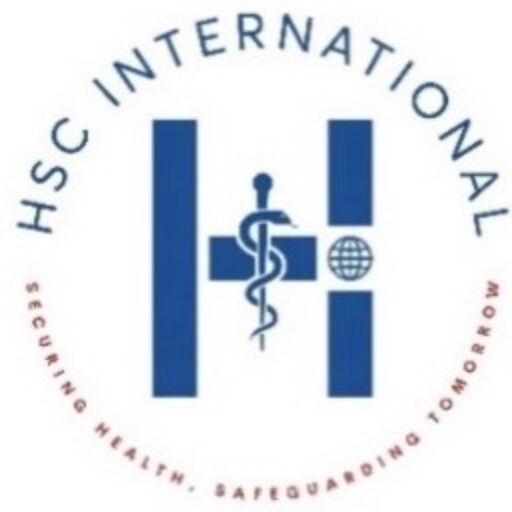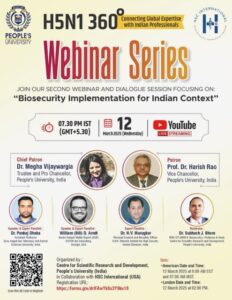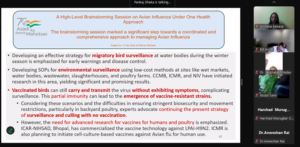A Seamless Event with Global Reach
The webinar ran remarkably smoothly, thanks to the organizing team and the leadership of Dr. Harish Rao, Vice Chancellor of People’s University. Dr. Rao opened the session by emphasizing the urgency of global cooperation, particularly in light of H5N1’s adaptation to mammals (e.g., cow-to-cow transmission in the USA). He highlighted India’s unique opportunity to refine its biosecurity measures by learning from international expertise—a theme that resonated throughout the event. The diverse international participation underscored the importance of collaborative, cross-border efforts in addressing transboundary diseases.
https://www.youtube.com/watch?v=pd9JJKYdFl8&feature=youtu.be
Global Context and Current Concerns
The webinar highlighted several alarming developments in the H5N1 landscape:
- Recent global spread of clade 2.3.4.4b along migratory bird pathways
- First documented cow-to-cow transmission in the US
- Increasing mammalian adaptation, including dairy cattle infections
- Specific mutations enhancing viral replication in mammalian hosts
- Environmental persistence abilities of the virus
Dr. Pankaj Dhaka emphasized that H5N1 is a “high-impact, transboundary, zoonotic disease affecting all three components of One Health: human, animal, and environment.” He noted the virus’s concerning “weapons” include rapid mutation capabilities, genetic reassortment potential, and broad host range.
Urban and Rural Biosecurity Strategies for India
Dr. Pankaj Dhaka, Assistant Professor at Guru Angad Veterinary and Animal Sciences University, delivered a compelling presentation on the epidemiological drivers of H5N1 and presented a comprehensive overview of urban and rural biosecurity strategies tailored to India’s diverse contexts.
Rural Challenges
Backyard poultry, a cornerstone of rural economies, often lacks adequate biosecurity, increasing outbreak risks from migratory birds and wildlife. Key challenges include:
- Extensive rearing systems close to natural water bodies
- Interaction between domestic poultry and wild birds
- Limited awareness and resources among small-scale farmers
- Significant role in rural food security and livelihoods despite biosecurity gaps
Dr. Dhaka called for enhanced surveillance of migratory birds and fostering a stronger biosecurity mindset among farmers to protect these vital rural assets.
Risk Factors in Urban Settings
- Live bird markets represent significant transmission hubs due to high human traffic
- Mixing of different species and poor infrastructure in markets
- Unregulated livestock movement in dense urban areas
- Peri-urban areas with close human-animal proximity
Live Bird Market Management
Dr. Dhaka highlighted China’s “1-1-1-0” policy as a model strategy:
- Daily cleaning
- Weekly disinfection
- Monthly rest day
- Zero overnight animal storage
These measures could significantly reduce transmission risks in India’s urban markets.
National Preparedness
Dr. Dhaka aligned these strategies with India’s National Action Plan for Prevention, Control, and Containment of Avian Influenza (Revised 2021), which focuses on:
- Early detection through regular surveillance targeting farms, wet markets, and water bodies
- Assessing disease patterns
- Comprehensive outbreak response protocols
- Recent initiatives for environmental surveillance and migratory bird monitoring
- Diagnostic network strengthening
- Achieving country freedom from the disease
Adapting Global Best Practices to Local Settings
Dr. William Arndt (Bill), Senior Subject Matter Expert at Soter Bio Consulting, shared insights on implementing effective biosecurity measures that balance international best practices with local contexts. He introduced the concept of “common sense biosecurity,” emphasizing risk-based, sustainable solutions adaptable to local constraints.
Common Sense Biosecurity
- Understanding the distinction between laboratory biosecurity (preventing intentional misuse) and animal biosecurity (protecting animals from infection)
- Focusing on risk assessment rather than uniform applications of standards
- Implementing performance-based approaches that allow for local adaptations
- Prioritizing what institutions need versus what they want
Key Biosecurity Pillars
Dr. Heard outlined five essential pillars for effective lab biosecurity:
- Physical security (securing facilities and equipment)
- Personnel security (screening and training)
- Material control and accountability (inventory management)
- Transport security (safe movement of samples)
- Information security (protecting data and intellectual property)
Practical Implementation Strategies
- Separating public and private (laboratory) spaces
- Centralizing freezer locations for better security and maintenance
- Implementing layered security zones with increasing protection
- Balancing security with operational functionality
- Proper waste management to prevent environmental spread (drawing parallels to lessons from Ebola outbreaks)
- Using locally available security solutions rather than expensive imported technologies
Sustainable Operations
Dr. Heard highlighted an ongoing project in India supporting operations and maintenance (O&M) for high-containment labs, ensuring long-term functionality. He emphasized: “The more support we provide to our operations and maintenance staff, the better off our facilities will be.”
Expert Panel Insights: Bridging Gaps in Biosecurity
During the panel discussion, several important points emerged that delved deeper into actionable strategies, addressing key challenges and opportunities for India:
- Laboratory Design & Risk Assessment: Dr. H.V. Murugkar, Principal Scientist and Biosafety Officer at ICAR National Institute for High Security Animal Diseases, stressed the importance of risk assessment in laboratory design and operations, cautioning against a “textbook” approach to biocontainment facilities. As he noted, “We need to understand what kind of work we are going to do in our labs. Are we going to culture viruses, or are we just going to carry out molecular diagnosis?”
- Waste Management: Proper handling and decontamination of lab waste were deemed essential to prevent environmental spread, drawing parallels to Ebola response efforts.
- Laboratory Capacity: Not every lab needs to handle H5N1; instead, regional diagnostic labs should be prioritized for faster sample confirmation, aligning with India’s tiered diagnostic plan (state to regional labs).
- Risk Communication: Effective communication with authorities and the public, alongside community education, was highlighted as a proven method to reduce disease spread.
- Training for Technicians: Comprehensive biosafety training and SOP adherence for lab staff were identified as top priorities to minimize exposure risks.
- Legal Framework: Panelists noted that India currently lacks specific biosecurity laws, with measures embedded in broader biosafety regulations (RCGM rules). They called for standalone legislation to strengthen lab protections.
- Localization of Solutions: Experts agreed that while global best practices provide valuable frameworks, implementation must be adapted to local contexts, resources, and regulatory environments.
Actionable Recommendations
The webinar concluded with a clear set of action items to enhance India’s H5N1 preparedness:
- Develop Regional Diagnostic Labs: Expand networks for timely pathogen confirmation, reducing travel time for samples
- Enhance Training Programs: Implement comprehensive biosafety and SOP training for lab technicians
- Conduct Local Risk Assessments: Tailor biosecurity measures to regional risks and socio-economic dynamics
- Engage Communities: Launch education initiatives to inform the public about protective measures
- Advocate for Legislation: Push for dedicated biosecurity laws independent of existing biosafety frameworks
- Optimize Resources: Focus on essential upgrades rather than equipping every lab with biocontainment facilities
- Strengthen Surveillance Systems: Particularly at the wildlife-domestic animal interface
- Implement Targeted Measures: Focus on high-risk settings like live bird markets
- Ensure Sustainable Operations: Maintain biosecurity systems with local expertise and supplies
- Adopt a One Health Approach: Integrate human, animal, and environmental health considerations
Key Themes for a One Health Approach
The session reinforced several overarching themes:
- Global-Local Synergy: Combining international best practices with India’s unique urban-rural and socio-economic contexts is vital
- Risk Assessment: A cornerstone for effective biosecurity, guiding lab design, farm protocols, and resource allocation
- Capacity Building: Strengthening surveillance, diagnostics, and training is essential to counter H5N1’s evolving threat
- One Health Integration: Addressing human, animal, and environmental health interconnections is critical, given H5N1’s zoonotic and economic impacts
- Resource Optimization: Sustainable, context-specific upgrades are key in resource-limited settings
The webinar underscored that successful H5N1 biosecurity requires coordinated actions at local, regional, national, and global levels, with measures tailored to specific contexts while adhering to fundamental principles of risk mitigation.
Looking Ahead
The H5N1 360° webinar series continues with upcoming sessions on clinical management, community preparedness, and diagnostic approaches. By integrating global expertise with local strategies, India can bolster its defenses against this transboundary zoonotic threat.



